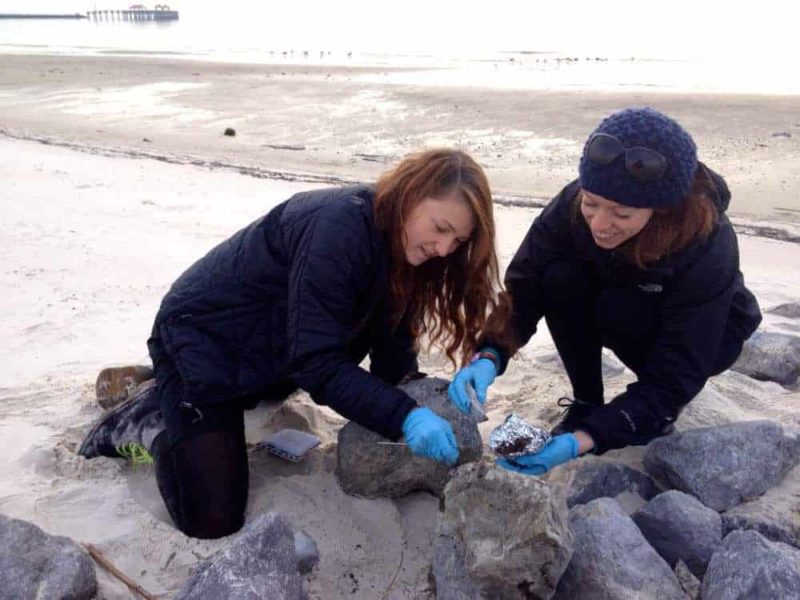Scientists from Haverford College and Woods Hole Oceanographic Institution investigated the presence of dispersants following the Deepwater Horizon oil spill.
They found various concentrations of a Corexit surfactant, dioctyl sodium sulfosuccinate (DOSS), in deep-sea coral and sediments six months after the spill and in beached oiled sand patties 26-45 months later. The researchers published their findings in the June 2014 issue of Environmental Science & Technology Letters: Long-Term Persistence of Dispersants following the Deepwater Horizon Oil Spill.
Responders used approximately 1.84 million gallons of Corexit 9527 and 9500A dispersants to diffuse Macondo oil into the water column preventing much of it from reaching the surface. Little is known about the persistence of DOSS in the marine environment, and previous studies focused on detecting DOSS in water. This study’s goal was to learn more about the presence of DOSS in solid materials from coastal and deep marine environments.
In December 2010, the team collected sediment and flocculent material (floc) from deep-sea coral communities that were visibly stressed (Mississippi Canyon 294) and that had no visible stress (Mississippi Canyon 388). Between June 2012 and January 2014, they collected oiled sand patties along Gulf Coast beaches. The weathered oil in floc and sand patties was found to be consistent with Macondo oil. They used liquid chromatography with tandem mass spectrometry to quantify DOSS and gas chromatography coupled with flame ionization detection and mass spectrometry to quantify oil.
All deep-sea sediment samples contained small amounts of oil and DOSS. DOSS was detected only in surface sediments no deeper than two centimeters which suggests a recent input. Oil and DOSS concentrations in surface sediments were varied, even among cores taken less than a meter apart, with no proportional relationship between dispersant and oil quantities. Researchers proposed that uneven dispersant application could cause this variability. Floc samples contained small amounts of oil and DOSS with a similar distribution as found in sediment, suggesting the same contamination source.
Oil-soaked sand patties all contained various small quantities of oil and DOSS. The oil/dispersant ratios were one to two orders of magnitude lower than the ratios calculated for the deep-sea sediments and floc samples. Since the oil was very weathered, the team hypothesized that DOSS likely became trapped in oil and sand solids which prevented it from interacting with surrounding water, thus limiting dissolution or degradation. The team suggested that this protective mechanism allowed DOSS to persist in the environment and that a similar mechanism might explain its lingering presence in other solid marine materials.
The U.S. Environmental Protection Agency has established water concentration levels of DOSS that may be harmful to marine life, but DOSS toxicity in solid materials is not known. Having confirmed the persistence of DOSS, lead author Helen White says that the next step is “to understand whether the oil and dispersant mixture is toxic and how it is exposed to the Gulf ecosystem.”
The study’s authors are Helen K. White, Shelby L. Lyons, Sarah J. Harrison, David M. Findley, Yina Liu, and Elizabeth B. Kujawinski (Environmental Science and Technology Letters, 2014, 1(7): 295–299). Lyons, Harrison and Findley were undergraduate students when this research was conducted.
If our reporting has informed or inspired you, please consider making a donation. Every contribution, no matter the size, empowers us to continue delivering accurate, engaging, and trustworthy science and medical news. Independent journalism requires time, effort, and resources—your support ensures we can keep uncovering the stories that matter most to you.
Join us in making knowledge accessible and impactful. Thank you for standing with us!


It is my understanding that the dispersent chosen by BP is only one molecule different from the ethyline glycol used as automotive anti-freeze.
For some time tiny BioGenesis Labs ( not affiliated with the Florida HGH lab of the same name infamous for baseball player juicing ) near Milwaukee has had a formulation that it states to be superior as a
oil spill dispersent.
I had recommended to the people at BioGenesis that they put in place a program to outsource the production and packaging of their product so that in the event of a major oil spill anywhere in the world, production and shipment could be scaled up enormously to meet the needs.
That recommendation was ignored.
Upon the event of the BP oil spill, the decision was made to go with the
sole provider able to produce product in the enormous volumes needed to address the gulf spill.
BioGenesis has produced some incredibly effective developments, most of which are setting on warehouse shelves collecting dust, instead of solving the world’s most challenging problems.
One of the problems of our society is that too many innovations are taken to the grave by their inventors with virtually no benefit to society.
We really need to improve our processes in intellectual property development.